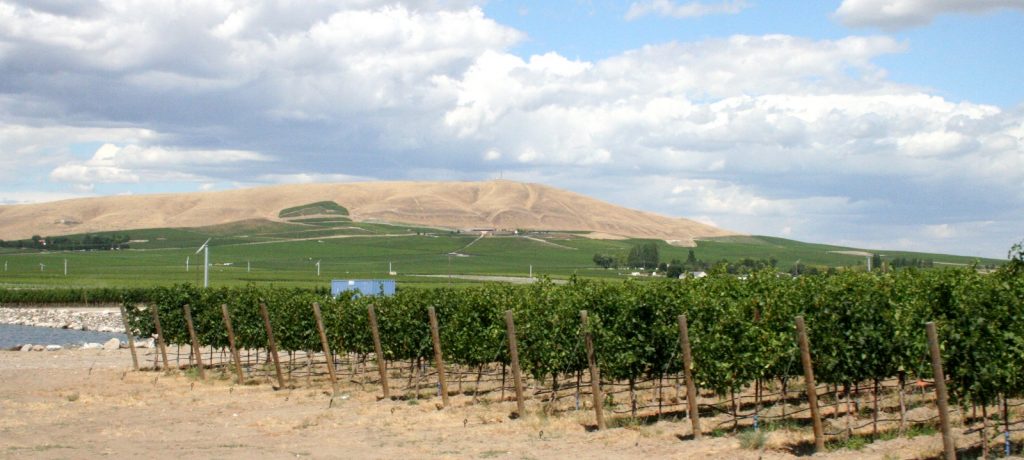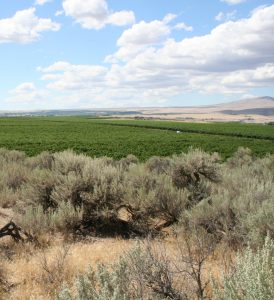 As mountains go, Red Mountain isn’t really that impressive. The Cascade Mountains just a bit to the west are much taller, and the red color only comes out in springtime when the cheatgrass blooms. In truth, the Yakima Indian name for the area, Kiona, a word that translates as “brown hills”, is a whole lot closer to reality.
As mountains go, Red Mountain isn’t really that impressive. The Cascade Mountains just a bit to the west are much taller, and the red color only comes out in springtime when the cheatgrass blooms. In truth, the Yakima Indian name for the area, Kiona, a word that translates as “brown hills”, is a whole lot closer to reality.
As a winemaking region, however, the tiny (approximately 6 square miles in area) Red Mountain AVA is spectacular. In just over 40 years it has gone from being almost literally the middle of nowhere to probably the most desirable address in Washington for growing grapes. At the root of this transformation are John Williams and Jim Howard, and the winery they built, Kiona Vineyards.

When John and Jim first scouted the area in the early 1970s, pretty much all that was in the future AVA was sagebrush and cheatgrass. But underneath were rich, fertile soils on south-facing slopes and near-ideal grape growing weather– as long as there was water available for irrigation, which John and Jim’s research indicated would be found about 500 feet down.
They drilled a well, brought in electricity, and planted the initial 12 acres of vineyard in 1975, starting with roughly equal amounts of Cabernet Sauvignon, Riesling, and Chardonnay. The first crop was harvested in 1978 and things went so well that John and Jim opened the Red Mountain’s first winery in 1980. Others followed, and in 2001 the region was granted AVA status.
Today, according to the Red Mountain AVA Alliance, those six square miles contain thirty-five vineyards covering approximately 1,400 acres. The Alliance estimates that another 1,000 acres are currently under development, with maybe a further 300 possible after that. The cachet of Red Mountain is such that every available plot seems destined for development, even the less-desirable locations.
Despite the early prevalence of white wine grapes, what Red Mountian has become known for is red wine. Across the AVA the most frequently planted grapes are Cabernet Sauvignon, Merlot, Syrah, Cabernet Franc, Malbec, and Petit Verdot. At Kiona Vineyards, Cabernet Sauvignon has been the big winner, becoming over 60% of their 230+ acres on Red Mountain (Kiona also owns vineyards in the Columbia Valley AVA), while all white varieties combined are now less than 10% of the total.
Kiona sells a portion of their crop to other winemakers. (It’s a pretty impressive list that includes at least three of the wineries I visited during my trip.) But they also make their own wines, several of which I had a chance to taste….
Estate Red Mountain Gewürztraminer 2014, $17
The Estate Red Mountain Gewürztraminer presents a rich, complex nose containing aromas of peach, melon, and grapefruit. A slightly sweet initial taste is followed by beautiful layers of spice and apricot flavors with a lingering finish. 112 cases produced.
As you might guess from the comments above, the plantings for most white wine grapes at Kiona go back to the early days, before they found out just how good the red wines were. The grapes for this wine are from a section of vineyard developed in 1978. It makes me wish they’d planted more of the stuff.
Estate Red Mountain Sangiovese 2012, $25
With a long growing season and virtually no chance of significant rain at harvest time, eastern Washington could have been purpose made for growing Sangiovese. Add to that near perfect weather in 2012 and you get an example of just how good Washington Sangiovese can be.
Classic aromas of leather and cherry with a hint of tobacco. Layers and layers of flavors that start with a dash of spice and leather and give way to a deep, lingering cherry. Well-balanced tannins and acidity.
Lemberger Estate Red Mountain 2013, $15
Also known as Blaufränkisch, most of the world’s production of this grape is Eastern Europe, notably in Austria where it is the country’s second most popular grape. Kiona claims to have been the first U.S. winery to produce Lemberger in 1980, and they are certainly one of the leading producers in the U.S.
The 2013 edition of Kiona’s Estate Red Mountian Lemberger is a light to medium body red wine with a pleasant raspberry/blackberry nose. It delivers berry flavors with medium tannins and a hint of spice. A simple wine that should go well with charcuterie or herb-roasted pork.
Estate Red Mountain Carmenere 2012, $35
Once widely grown there, Carmenere is sometimes called the lost grape of Bourdeaux. It was ravaged by the phylloxera epidemic of the 19th century and often replaced with other varieties when the vineyards were replanted. Reasons given for the change away from Carmenere include poor results when grafting it onto phylloxera resistant root stock, susceptibility to mildew, and the need for a long growing season. None of these are likely to be a problem in Washington.
Carmenere is known for producing deeply colored wines, and this one delivers a dark ruby color with purple notes. The complex nose contains aromas of herbs, plum, earth, and baking spice. This is a medium body wine with flavors of plum and sour cherry. As a single varietal wine, I think Carmenere benefits from warmer conditions (such as occurred in 2013 or 2014 in Washington), but Kiona’s 2012 edition is an interesting wine that should pair well with many meat dishes.
Old Block Cabernet 2012, $65
One-third of Kiona’s initial 1975 planting was Cabernet Sauvignon. This wine, made entirely using grapes from that block of (in 2012) 37-year-old vines, has an opulent dark ruby color with purple notes. It is one of those wines that is a pleasure just to smell, with seductive aromas of pepper, anise, and raspberry. When you do get around to tasting it, you’ll find lovely red fruit flavors with anise notes, all framed by well-balanced tannins. Kiona’s 2012 Old Block Cabernet is a delicious, elegant wine that is drinking well now and should continue to develop for years.
Estate Red Mountain Reserve 2013, $42
Made from 52% Cabernet Sauvignon, 35% Merlot, 6% Petit Verdot, 3% Malbec, 2% Cabernet Franc, and 2% Carmenere, the Estate Red Mountian Reserve is Kiona’s version of a Bourdeaux blend. They describe it as their flagship product, the definitive wine of their vineyards, of their viticulture, and of their plantings on Red Mountain.
The wine is a beautiful dark ruby color. It has a full nose with aromas of green pepper and baking spice and flavors of raspberry and currant supported by well-integrated tannins. Complex and nicely balanced, Kiona’s Estate Red Mountain Reserve is a rich wine that is quite enjoyable now. But do try to save some as it likely to be even better after another three or four years.
“First Crush” Late Harvest Sauvignon Blanc 2006, $20 (375 ml)
If I heard the story correctly (always a valid question when I am tasting, as hearing is the least engaged of my senses), this wine came about only because another winery was unable to use some grapes they had ordered. I’m also told that in its youth you couldn’t give the stuff away (and, indeed, I’ve seen old listings offering it for $5.99). However, patience can be a virtue with wine, and here is a good example.
Produced from nearly frozen Columbia Valley grapes that measured 37 degrees brix at harvest, this wine has an alluring bright golden color. With 17% residual sugar, it is sweet, but with layers of tropical fruit flavors and a subtle complexity that yields a wine that is rich, beautiful, and not too heavy. Available only at the tasting room, this is a treat for dessert wine fans that get the chance.
